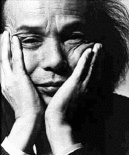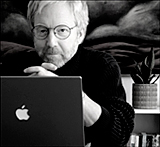Toru Takemitsu at the Library of Congress
The Washington Post 10/11/05: For those concertgoers who would rather jump through a plate-glass window than submit to an evening of contemporary music, the works of Toru Takemitsu usually come as a revelation. The Japanese composer's soundscapes -- while utterly contemporary and often brain-breakingly complex -- are also gorgeous, and the contemplative, nature-oriented sensibility behind them resonates immediately with modern audiences.
 Takemitsu, who died in 1996 at 65, was an unusual and almost Yoda-like character. A diminutive autodidact who learned Western music as a bedridden youth, he was discovered by Stravinsky, became a key figure in the experimental ferment of the 1960s and '70s, revered Claude Debussy but hung out with John Cage, integrated Eastern and Western music for the first time, reinvented the language of film scoring and -- incidentally -- emerged as the 20th century's most provocative and influential Asian composer.
Takemitsu, who died in 1996 at 65, was an unusual and almost Yoda-like character. A diminutive autodidact who learned Western music as a bedridden youth, he was discovered by Stravinsky, became a key figure in the experimental ferment of the 1960s and '70s, revered Claude Debussy but hung out with John Cage, integrated Eastern and Western music for the first time, reinvented the language of film scoring and -- incidentally -- emerged as the 20th century's most provocative and influential Asian composer.
This extraordinary legacy was explored over the past two weeks in "Mirror of Tree, Mirror of Field: The Life and Music of Toru Takemitsu," a mini-festival held at the Library of Congress. It opened with a week of film -- appropriately so, as Takemitsu came to the world's attention through his 93 film scores. But the composer's other, non-filmic works (more than 180 concert pieces, as well as theater and dance music) are steadily moving into the mainstream of the concert repertoire. A concert Saturday at Coolidge Auditorium traced a broad arc through his chamber music, from the early "Distance de Fee" (played with great intelligence by Shoko Aki on violin and Audrey Andrist on piano), to his last completed work, "Air," an elegant flute soliloquy performed by Paula Robison.
Traces of Debussy (and Takemitsu's other idol, Olivier Messiaen) surfaced elsewhere during the evening. "And then I knew 'twas Wind," performed with great precision and beauty by Robison with violist Maria Lambros and harpist Naoko Yoshino, echoed Debussy's savage "Sonata" for those same instruments but was far more than mere homage. Among the other key pieces was "Stanza II" for harp and tape, a 1971 work that stretched the harp's sonorities into fantastical new territory and was brought off with a deft and delicate touch by Yoshino.
But perhaps the most extraordinary moments of the evening were in Robison's bravura performance of "Voice," a spectacular tour de force for solo flute from 1971. Multiphonics, timbral trills, key clicks, microtonal slides, shouting and whispering and hissing -- Robison used them all to create a haunted figure, alone in an internal wilderness of terror and awe.
 Takemitsu, who died in 1996 at 65, was an unusual and almost Yoda-like character. A diminutive autodidact who learned Western music as a bedridden youth, he was discovered by Stravinsky, became a key figure in the experimental ferment of the 1960s and '70s, revered Claude Debussy but hung out with John Cage, integrated Eastern and Western music for the first time, reinvented the language of film scoring and -- incidentally -- emerged as the 20th century's most provocative and influential Asian composer.
Takemitsu, who died in 1996 at 65, was an unusual and almost Yoda-like character. A diminutive autodidact who learned Western music as a bedridden youth, he was discovered by Stravinsky, became a key figure in the experimental ferment of the 1960s and '70s, revered Claude Debussy but hung out with John Cage, integrated Eastern and Western music for the first time, reinvented the language of film scoring and -- incidentally -- emerged as the 20th century's most provocative and influential Asian composer.This extraordinary legacy was explored over the past two weeks in "Mirror of Tree, Mirror of Field: The Life and Music of Toru Takemitsu," a mini-festival held at the Library of Congress. It opened with a week of film -- appropriately so, as Takemitsu came to the world's attention through his 93 film scores. But the composer's other, non-filmic works (more than 180 concert pieces, as well as theater and dance music) are steadily moving into the mainstream of the concert repertoire. A concert Saturday at Coolidge Auditorium traced a broad arc through his chamber music, from the early "Distance de Fee" (played with great intelligence by Shoko Aki on violin and Audrey Andrist on piano), to his last completed work, "Air," an elegant flute soliloquy performed by Paula Robison.
Traces of Debussy (and Takemitsu's other idol, Olivier Messiaen) surfaced elsewhere during the evening. "And then I knew 'twas Wind," performed with great precision and beauty by Robison with violist Maria Lambros and harpist Naoko Yoshino, echoed Debussy's savage "Sonata" for those same instruments but was far more than mere homage. Among the other key pieces was "Stanza II" for harp and tape, a 1971 work that stretched the harp's sonorities into fantastical new territory and was brought off with a deft and delicate touch by Yoshino.
But perhaps the most extraordinary moments of the evening were in Robison's bravura performance of "Voice," a spectacular tour de force for solo flute from 1971. Multiphonics, timbral trills, key clicks, microtonal slides, shouting and whispering and hissing -- Robison used them all to create a haunted figure, alone in an internal wilderness of terror and awe.


Reader Comments